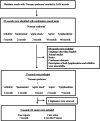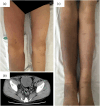Recurrent cellulitis associated with lymphoedema in Noonan syndrome: case reports with RIT1 variants and literature review
- PMID: 40467618
- PMCID: PMC12137658
- DOI: 10.1038/s41439-025-00315-1
Recurrent cellulitis associated with lymphoedema in Noonan syndrome: case reports with RIT1 variants and literature review
Abstract
Noonan syndrome (NS) is a RASopathy, a disorder caused by genetic alterations involving the Ras/mitogen-activated protein kinase pathway. It causes characteristic clinical manifestations, including facial dysmorphism and congenital cardiac defects. Occasionally, lymphoedema and recurrent cellulitis occur in patients with NS, potentially escalating to lethal conditions. Despite the frequent association of cellulitis with lymphoedema in NS, features susceptible to these complications have not been fully characterized. We encountered two patients with NS carrying RIT1 pathogenic variants, who were treated for recurrent lower leg cellulitis since their teenage years, which occasionally progressed to sepsis. Here we retrospectively examined these patients with NS and recurrent cellulitis on the background of lymphoedema and reviewed published cases of NS with lymphoedema and cellulitis up to March 2024 to elucidate the clinical and genetic features of this subgroup. Our literature review identified 16 additional patients with NS with similar complications. Among the 18 patients (15 men), genetic analyses revealed pathogenic variants in PTPN11 and RIT1 in 4 patients each, with the latter occurring more frequently than commonly observed. The patients developed lymphoedema by 15 years of age, predisposing them to cellulitis by 23 years of age. Notably, four of the five patients with sepsis had congenital heart defects, with a higher prevalence than that generally reported in NS. This study highlights the characteristics of genetic variants, congenital cardiac anomalies and heightened risk of recurrent cellulitis in patients with NS, emphasizing the need for early intervention with prophylactic antibiotics and surgical treatment to mitigate these risks.
© 2025. The Author(s).
Conflict of interest statement
Competing interests: The authors declare no competing interests. Ethics approval and consent to participate: The Ethical Committee of Tachikawa Hospital approved this study (approval number: 2021-13). Consent for publication: Written informed consent was obtained from both patients.
Figures



Similar articles
-
Clinical features and molecular genetics of patients with RASopathies: expanding the phenotype with rare genes and novel variants.Eur J Pediatr. 2024 Dec 27;184(1):108. doi: 10.1007/s00431-024-05825-8. Eur J Pediatr. 2024. PMID: 39725732
-
Molecular and clinical profile of patients referred as Noonan or Noonan-like syndrome in Greece: a cohort of 86 patients.Eur J Pediatr. 2022 Oct;181(10):3691-3700. doi: 10.1007/s00431-022-04574-w. Epub 2022 Jul 29. Eur J Pediatr. 2022. PMID: 35904599
-
Genotype and phenotype in patients with Noonan syndrome and a RIT1 mutation.Genet Med. 2016 Dec;18(12):1226-1234. doi: 10.1038/gim.2016.32. Epub 2016 Apr 21. Genet Med. 2016. PMID: 27101134
-
A novel heterozygous RIT1 mutation in a patient with Noonan syndrome, leukopenia, and transient myeloproliferation-a review of the literature.Eur J Pediatr. 2016 Apr;175(4):587-92. doi: 10.1007/s00431-015-2658-6. Epub 2015 Oct 31. Eur J Pediatr. 2016. PMID: 26518681 Review.
-
Lymphatic Abnormalities in Noonan Syndrome Spectrum Disorders: A Systematic Review.Mol Syndromol. 2022 Feb;13(1):1-11. doi: 10.1159/000517605. Epub 2021 Sep 10. Mol Syndromol. 2022. PMID: 35221870 Free PMC article. Review.
References
LinkOut - more resources
Full Text Sources
Miscellaneous

